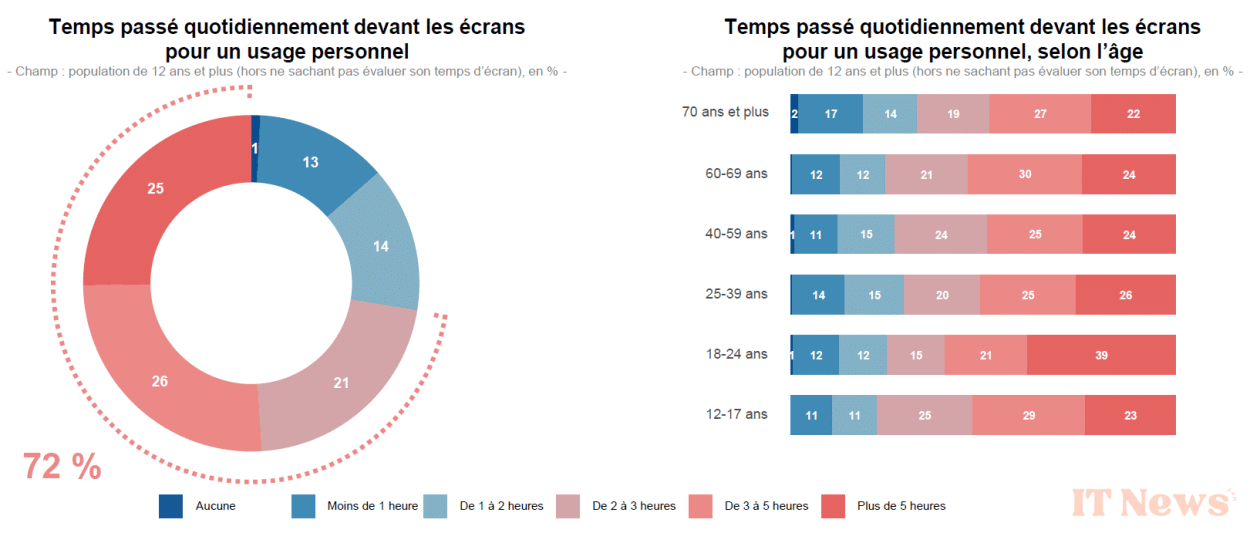To shed light on these trends, the 2025 digital barometer is based on a study conducted among a representative panel of the French population aged 12 and over.
Landline phones are picking up, mobile phones are triumphing
In the space of a year, landline phones have lost ground in French homes. Only 74% of households still have them, compared to 79% previously. A silent, but revealing decline. Conversely, mobile phones continue their conquest unabated: 98% of French people own one, and among them, 91% use a smartphone.
This widespread adoption does not necessarily lead to unbridled consumption. Nearly half of users do not use up the data included in their plan. Yet, across all ages, the observation is clear: the mobile phone has become central, sometimes even omnipresent. A trend that is, by force, giving rise to a phenomenon that was still marginal until recently: nomophobia, the difficulty of doing without one's smartphone.
Online procedures: e-administration in use
Nearly three-quarters of French people now use online administration. A habit that has become firmly established since the health crisis, which has acted as an accelerator. Fewer trips, greater simplicity: digital technology is becoming the preferred channel for many procedures, from making medical appointments to filing tax returns.
This transition is accompanied by real time savings for users. Above all, it reflects a structural change in public services, where efficiency increasingly depends on digital interfaces.
Artificial intelligence is becoming mainstream... with caution
A third of French people have already used a solution integrating artificial intelligence. This is one of the most striking figures for 2024. Among 18-24 year-olds, this proportion is climbing further, with AI being used in particular for educational or professional purposes.
But enthusiasm is not without reservations. More than one in two French people are worried about the effects of the massive integration of AI into society. The spectre of a negative impact on employment, or even on the environment, fuels a certain scepticism. If artificial intelligence progresses, it will have to do so under the watchful eye of a population demanding guarantees.
Exposure to screens, especially among young people
Screen addiction is here to stay. 65% of respondents admit to having trouble going without their smartphone for even a day. And 25% spend more than five hours a day in front of a screen—a proportion that rises to 39% among 18-24 year-olds.
However, this hyperconnectivity is not necessarily synonymous with withdrawal or passivity. It is also accompanied by an expansion of access to information, culture, and services. With 94% of French people regularly connected, the Internet has become an extension of everyday life, even if it is not always synonymous with inclusion.
Digital Divide and the Challenge of Trust
Behind the flattering connection figures, disparities remain. Particularly when it comes to carrying out administrative procedures online, some users still struggle to navigate the process. Digital inclusion remains an ongoing project, requiring increased support efforts.
Another sensitive issue: the protection of personal data. Concerns about the security of information shared online are growing. Trust in digital services is also faltering because transparency is sometimes lacking. To continue to progress, digital technology will also need to reassure.Social networks, streaming: ever more fluid consumption
Social networks remain essential to daily digital life: 75% of Internet users consult them every day. Massive usage, which reflects their now structuring role in access to information and social interaction.
Video on demand is also experiencing sustained growth. More than half of French people regularly use these platforms, favoring à la carte and instant content. A logical evolution, in an environment where immediacy has become the norm.
Towards a more sustainable digital transition?
While digital uses are becoming widespread, ecological concerns are also growing. The question of the environmental footprint of digital technology is no longer marginal. It is gradually becoming an imperative for businesses, public authorities, and citizens.
Technologies will now have to combine performance and efficiency. It is on this condition that digital technology will be able to continue to transform uses, without aggravating the imbalances that it sometimes contributes to reinforcing.





0 Comments